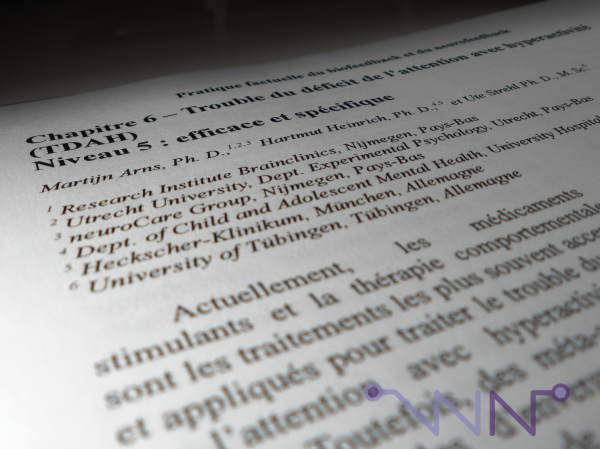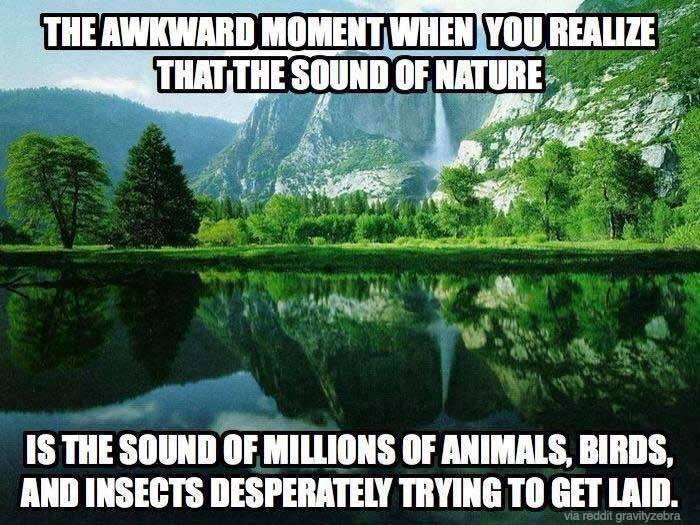Evidence-Based Practice in Biofeedback & Neurofeedback : a reference book
on 09 January 2019
In life, you have two ways of looking at things: either negatively or positively.
And personally, I'm more of a positive guy:
- Take a volcanic eruption: certainly, it will kill all the inhabitants of the village, but the slag deposited during the eruption will make the land more fertile afterwards.
- Take a mass extinction: certainly, many species will disappear, but the released biological niches will allow the development of new species.
- Take the Human: certainly, he destroys his environment, but the Earth will not stop turning and will survive the Human.
Always remain positive, accept that disaster is inevitable but that in the long term it will bring good things1.
And that's the morality of this blog. Following my setbacks with the pro-NeurOptimal, a strange series of events occurred.....
- November 28, 2018: I am contacted by Mark Schwartz, who would like to share my article "NeurOptimal finally admits not to be Neurofeedback" in the group "Neurofeedback Exchange".
- November 29, 2018: Bruno Warnotte comments on Mark's sharing and the name telling me something, I look at his profile and see that he has finished translating the book Evidence-Based, so I contact the AAPB - the Association of Applied Psychophysiology and Biofeedback - to check in.
- December 3, 2018: Bruno asks me for my address.
- A few days later: a package arrives containing the book "Evidence-Based Practice in Biofeedback & Neurofeedback" in French.
Now I know what you're thinking. Synchronity? Karma? Law of attraction? Divine intervention (the one you prefer according to your religion, we are tolerant here)? Such a series of events is not possible in such a short time!
The esoteric interpretation is tempting, but. Personally, I think it's the result of a stupid networking on the Internet..... After almost a year of running this blog and being the only one on the niche of skeptical neurofeedback information with Jean-Loup, here we are....
(Finally, let's be honest, I think the word Synchronicity has a beautiful sound. So I had to find a way to place it on this blog, that's it - it's also a great song -).
This is the time to be transparent: so I received this book for free from its author. Neither the AAPB nor the author asked me to promote it. I deliberately wanted to talk about it and asked for permission to quote excerpts from the book.
On a personal level, I wanted to offer the book to a reader, but as Bruno kindly dedicated it to me, in fact, I will keep it... #ScientistGroupie 
What is the book Pratique factuelle du Biofeedback et du Neurofeedback ?
Above all, it is the French translation of the AAPB's book "Evidence-Based Practice in Biofeedback & Neurofeedback" which is in its third version.
Evidence-Based Practice in Biofeedback and Neurofeedback (3rd ed.) is the most comprehensive review of research in the field of neurofeedback and biofeedback available to clinicians. The diversity of topics will extend the clinicians knowledge. This serves as a vital resource to validate the use of these modalities. Perhaps the most important aspect of this review is the ranking of the studies for each disorder based on the methodological quality of the research. I recommend this book, not only to every clinician, but to all researchers interested in doing biofeedback and neurofeedback research. This will allow researchers to explore the extent of research thus far done, and will open the door to new ideas that can be investigated in the future.
And to review a technique as vast as biofeedback: there can't be a single author. In fact, there are 55 authors, each having participated in one or more chapters of the book.
What I appreciate is that at the beginning of each chapter, the function of each person and their attachment laboratory are specified (Ph. D. is the abbreviation for Philosophiæ doctor, literally "doctor of philosophy", the most common title of a doctoral degree... even if the discipline is not philosophy2).

So we are not dealing with strangers, at best, they are researchers who are listed on Pubmed and at worst, well, they are researchers who are listed in Pubmed3.
And during 40 chapters of scientific review, 44 pages of bibliography (to read the original publications) and 4 introductory chapters, this complete 216-page synthesis reviews the state of knowledge in the field of biofeedback. Think of my article "Finding, accessing, reading, reading, translating and understanding science", if you want to read some of the publications that are behind a paywall.
A bibliography is the central element of any scientific publication, whether it is an experimental study, a doctoral thesis or a book, as here.
It allows any researcher to verify the author's allegations, or even to "go further", by reading the publications cited.
Often, a bibliographic reference takes this form (there may be variations, but the information given remains the same):
Chaussenot R, Edeline JM, Le Bec B, El Massioui N, Laroche S, Vaillend C. (2015) Cognitive dysfunction in the dystrophin-deficient mouse model of Duchenne muscular dystrophy: A reappraisal from sensory to executive processes. Neurobiology of Learning and Memory, 124, 111-122.
That is, in detail:
- the list of authors: in general, the first name is the main experimenter (here, a doctoral student) and the last name is the project director (here, the doctoral director). In the middle, they are other experimenters who collaborated in the study;
- the year: here, the article was published in 2015;
- the title: well.... the title of the article ;
- the journal: in the example and in italics, the journal that accepted the article is specified;
- the volume: in the example and in bold (here, 124) is specified the volume of the journal where the article is published;
- page numbers: finally, 111-122 refers to the page numbers of the article in the volume. This shows, for example, that the article is 11 pages long.
What to do with this information?
- Knowing the authors and their role allows you to follow the publications of a particular team. Typically, the scientific world is ultra-precise and ultra-specialized, so it's a small world. And if people are working on related topics, in general, they will follow their respective publications. It also makes it possible to follow the evolution of science. During my thesis, I fell in love with Hinton's publications. Between 2000 and 2008, several of their studies contradict each other and specify a specific subject. So I searched all of Hinton's publications to see how this author had evolved in her thinking - on a subject close to my thesis topic -.
- Knowing the year makes it possible to situate the age of a study and to place it in its scientific context.
- Well, the title is obvious: in science, we rely on long titles that allow colleagues to quickly see if paper can interest them. We're for knowledge, not clickbait.
- The journal allows you to see if it is a good journal (impact factor) or if it is a journal you are used to reading, etc...
- The volume and page numbers, in my opinion, are mostly a pre-Internet relic, where journals only existed in paper format. This made it possible to find an article very quickly in the huge libraries of scientific journals that a lab / faculty library may have.
The bibliographic reference is the identity card of a scientific production.
But above all, with this reference, we can find the original publication. On Pubmed, on Google Scholar, on the newspaper's website. If the article is not found, it means either that the reference is incorrect (therefore the author's comment is invalid), or that the original article has been retracted / withdrawn (for example, for fraud) so here too, the author's comment becomes invalid.
So 44 pages of bibliography....
..... that's a lot of scientific articles cited! I count roughly 18 per page, almost 800 studies cited and discussed in this book. It is not an anecdotal, it is a major synthesis work on the part of the authors and that is why they are so numerous.
Who is this book for?
I think this book is only for professionals. It provides a very good basis for the clinic's work and the keys to further laboratory research.

For the general public, I refer you to the third figure in my article "NeurOptimal communication debunked", where Neurosens synthesized the level of evidence of neurofeedback for each pathology. In fact, they "simply" used the nomenclature of this book on a single slide.
Despite everything, the first four chapters of the book are quite generalist and it is mainly these that will interest me here.
In these articles, which are only popular articles, I try to show you that neurofeedback is the result of intense scientific research, that its mode of action and criteria of use are precise. Neurofeedback is not a miracle technique and sometimes other techniques are more appropriate.
For example, if a "Chronic Pain" chapter exists, suggesting that biofeedback has an effect on it, the chapter begins by distinguishing 16 types of chronic pain, where biofeedback is effective to not studied. In this case, neurofeedback studies are incomplete and most of the evidence we have is based on biofeedback.
It is therefore important not to want to see neurofeedback at all costs as the solution to everything, as I see all too often in neurofeedback groups on Facebook or in the communication of some institutes on social networks. But that's a point I'm saving for a future article.
Back to the basics: definition of biofeedback
As I said, the first chapters are very interesting for the general public, especially because it lay the foundations of the discipline. According to the AAPB, the ISNR - International Society for Neurofeedback and Research - and the BCIA - Biofeedback Certification International Alliance - "biofeedback is a process that allows a person to learn to modulate the functions of his body in order to improve his health and performance" (Schwartz, 2010). And so, neurofeedback is a particular type of biofeedback applied to the brain.
Simply put: if there is no conscious learning, it is not biofeedback. That's it, that's all. With this, you already have a good key to differentiate between solutions that claim to be biofeedback and those that are not.
The rest of the definition is just as interesting:
Precise devices measure physiological functions, such as brain waves, heart function, breathing, muscle activity and skin temperature.
What impact will this have? Without a scientific publication testing the accuracy of the measuring device used, it is impossible to know if the biological signal measurement is correct. This means, for example, having a minimum return of electrode impedance in neurofeedback. This once again allows us to refine the quality of the equipment chosen. And that's why I spoke, in my previous articles, in favour of Muse, Versus or Koala: these devices have proven that they can properly pick up the biological signal. That's the basis.
Finally, the definition concluded:
Making this information perceptible, often in combination with emotional and behavioral changes and changes in thinking, promotes the desired physiological changes. Over time, these changes can continue without the use of a device.
The first part refers to the need for coaching during the sessions, while the second and last sentence refers to learning that will be sustainable, if well done.
This is where I remain cautious about the Koala solution: without a practitioner, nothing says that the machine works (that's why I wait for their scientific study before making a decision). As precise and well designed as it is. In addition, I have spoken with a practitioner who has dedicated his life to neurofeedback - an interview that will be the subject of my future article - and he raises an important point about neurofeedback at home: in Koala's case, it puts the parent in the position of a therapist, even though he is not trained for it!
Finally, this definition clearly states that "biofeedback aims to acquire self-regulatory techniques and put them into practice during activities of daily living outside the clinic". So, if someone still tells you that bio/neurofeedback is not sustainable, give them this advice from me:

To tell you the truth, we are here at page "i" of the book (its second paragraph, exactly), in the Foreword. So, I didn't even start the book that my little heart is beating in front of so much precision in so few words. Human emotions are beautiful.
Biofeedback: a natural, holistic therapy in which the patient is the actor of his or her health
In 2019, I am appalled, if not completely frightened by the general public's tendency to adhere to pseudosciences or bullshit theories4. And to doubt the scientific method, while it has allowed the emergence of modern society.

So I too would like to take part in this debate.
You love:
- organic products;
- natural techniques;
- holistic techniques;
- techniques where the patient is the actor of his own change....
I have THE solution for you!
So no, it's not the organic label (which is bullshit), nor naturopathy (which is bullshit), nor even sophrology (which is also bullshit), it's....... well, biofeedback. Remember, I'm talking about biofeedback on my blog.
The advantages of biofeedback are numerous:
- it is guaranteed 100% organic because you do not ingest any active ingredients (a little like homeopathy, huh);
- it is also completely natural, because the air you breathe during the session is not polluted by pesticides and that is all you will ingest (on pollution related to solvents in interior paints, I will not get involved, though);
- it is also holistic by emphasizing the body's mutual influence on the mind and the body's ability to recover on its own;
- it is above all based on learning, so your own action on yourself.
So here we are, biofeedback is good for your health and it's ALSO validated by the scientific method!
Some tips for biofeedback practitioners
The first chapter will focus on how to set up biofeedback, explaining:
- its terms and conditions;
- the importance of the client/patient relationship as a factor in the success of the therapy;
- learning objectives and application.
These few pages, which every practitioner knows unconsciously, nevertheless capture the heart of the practice and the importance of the elements involved in biofeedback.
As this article is not intended to copy/paste the book (I don't have the authorization, eh), I can only give you some elements that will answer the question: is this book worth it?
Necessarily, yes, otherwise I won't spend days working on this article, haha.
Explanation of efficiency levels
Chapter 2 details the nomenclature of efficiency levels established by the AAPB and ISNR.
So we have:
- Level 1: Not evidence-based. This indicates a lack of research on the subject.
- Level 2: Possibly effective. The studies lack a control group, so let's say it's indicative....
- Level 3: Probably effective. We are beginning to get serious, but the methodological biases of the studies do not allow us to be certain.
- Level 4: Effective. The description says it all.
- Level 5: Effective and specific. Here, we tick all the boxes of the scientific methodology, with comparisons to placebo, drugs, quality statistics in short... it's all good.
For the more curious, you can find the detailed list on the AAPB website.
It is important to keep in mind that this classification is temporary. If new evidence confirms or disproves the effectiveness of biofeedback on certain diseases, the level of effectiveness will be updated.
Science is the art of proving you wrong. So the new evidence may challenge previous studies. That's the game. And where you have to remain humble.
Further recommendations to practitioners
Chapters 3 and 4 return in detail to the roles of the BCIA and the professional standards and ethical rules relating to the practice of biofeedback.
Again, this will be of interest to practitioners, more than the general public.
Basically, the document recalls:
- the responsibilities of the practitioner: applying rigorous standards, we do not do pseudoscience;
- the limit of her/his skills: knowing himself well and knowing biofeedback makes it possible to advise the patient as well as possible;
- ethical standards: we do not charge pseudoscience on the back of biofeedback, we declare our conflicts of interest and others...... too often forgotten by unscrupulous people;
- ... and a whole lot of other things, buy the book, in fact, it's really great (and I didn't even get paid to say that!
 ).
).

The core of the book: factual evidence of biofeedback in science
Once you get to Chapter 5, you get to the core of the matter with the adult headache, which is classified as level 4 (therefore, effective).
Depending on the complexity of the pathology and the number of studies, the chapters will vary in size. What I can tell you is that there are 39 chapters (for as many pathologies) treated in 154 pages. So, on average, each chapter is 4 pages long.
It's concise, all sources are cited in a References section and you will very quickly get a good idea of the state of biofeedback research in 2016.
Yes, in 2016, the book is already 3 years old. But it is not out of date 
So let us be clear: this is not a recipe book. You are not going to have a guide to electrode placement for each pathology or miracle advice for your practice. We're talking science here, not magic.
Again, bio/neurofeedback is about using an imaging technique (usually the EEG in the case of neurofeedback) to understand the source of brain dysregulation based on the clinical profile. And this book will present (and list in References) the studies that have followed this process: it is then up to you to read them, to see the protocols used and apply them in your practice.
References are also made to topics I discussed with Thomas in my previous article, including Z-Score or Slow Cortical Potential (SCP).
Think of it as a dictionary, which will give you the definition (effectiveness) of biofeedback on each pathology, but only with references to the practical application (the scientific articles cited). Or like a compass that will show you the direction of Japan, but you will still have to move your ass and take a plane to get in and enjoy the Torii Itsukushima-jinja.
Conclusion and purchase of the book
The book "Evidence-Based Practice in Biofeedback & Neurofeedback" is on sale on the AAPB website.
But, currently, I cannot give you a link to buy the book in French. It is not yet distributed in France. I am in contact with Bruno Warnotte, its author, to be informed as soon as this is the case. So, what I can advise you is to write to me via my contact form if you are interested. I'll keep a list and contact you all as soon as I have information.
It is also an approach that can allow Bruno to know the demand and therefore to see the quantities as accurately as possible, making it possible to save money (printing in quantity and few losses), in short, it is nice to show up in advance! 
1 And don't tell me in comment that I have a strange notion of positivity... ;-)
2 Obviously, according to Wikipedia, this is not the same as the title of a French postgraduate doctorate, whereas..... we all use it that way.
3 I only checked 20 random names on Pubmed, and as it was always positive, I was lazy...
4 This interview of a pro-homeopathy by Mr Sam is revealing of the emptiness of critical thinking of this person who has all the conflicts of interest in the world with homeopathy contrary to what she says...
Did you like this article? Then support the blog and share it with your friends by clicking on the buttons* below :
Article url :
http://en.chaussenot.net/pratique-factuelle-du-biofeedback-et-du-neurofeedback-un-ouvrage-de-reference
* These sharing buttons are respectful of your privacy and avoid tracking by social networks.



